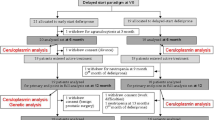Abstract
Ceruloplasmin functions as a ferroxidase in iron metabolism. Parkinson’s disease (PD) is characterized by an increase in brain iron. We postulated that lower circulating ceruloplasmin levels in PD would result in rapid brain iron accumulation and an earlier age of onset. Consecutive PD patients were separated into subgroups with younger (≤ 60 years, n = 62) and older ages of onset (> 60, n = 29), and compared to non-PD controls (n = 40). A oneway ANOVA comparing ceruloplasmin levels showed a very robust effect [F(2,128) = 46.4, p < 1e-99]. Post hoc analysis demonstrated that the younger-onset PD subgroup [22.0 mg/dl ± 6.5 SD] had a lower mean ceruloplasmin level compared to the older-onset PD subgroup [35.7 ± 10.4] and controls [35.6 ± 8.4], whose levels did not differ from each other. Ceruloplasmin levels showed robust correlation with age of onset in all 91 PD patients [r = 0.56, r2 = 0.31, p < 0.0001] but not in the non-PD controls [r = 0.16, r2 = 0.03, not significant]. Mode of onset and duration of PD showed no relationship to ceruloplasmin. Serum copper and ferritin, available in most patients, did not differ between the PD subgroups. Younger-onset PD patients have significantly lower levels of serum ceruloplasmin compared to those with older-onset PD. Ceruloplasmin may play a role in the etiopathogenesis of younger-onset PD patients and merits further study.
Similar content being viewed by others
References
Gotz ME, Double K, Gerlach M, Youdim MB, Riederer P (2004) The relevance of iron in the pathogenesis of Parkinson’s disease. Ann N Y Acad Sci 1012:193–208
Hochstrasser H, Bauer P, Walter U, et al. (2004) Ceruloplasmin gene variations and substantia nigra hyperechogenicity in Parkinson disease. Neurology 63:1912–1917
Berg D, Hochstrasser H, Schweitzer KJ, Riess O (2006) Disturbance of iron metabolism in Parkinson’s disease – ultrasonography as a biomarker. Neurotox Res 9:1–13
Jenner P (2003) Oxidative stress in Parkinson’s disease. Ann Neurol 53:S26–S36
Rouault TA, Cooperman S (2006) Brain iron metabolism. Semin Pediatr Neurol 13:142–148
Harris ZL, Takahashi Y, Miyajima H, Serizawa M, Mac Gillivray RT (1995) Aceruloplasminemia: molecular characterization of this disorder of iron metabolism. Proc Natl Acad Sci USA 92:2539–2543
Kim KS, Choi SY, Kwon HY, Won MH, Kang TC, Kang JH (2002) The ceruloplasmin and hydrogen peroxide system induces alpha-synuclein aggregation in vitro. Biochimie 84:625–631
Jiménez-Jiménez FJ, Fernández-Calle P, Martínez-Vanaclocha M, et al. (1992) Serum levels of zinc and copper in patients with Parkinson’s disease. J Neurol Sci 112:30–33
Tórsdóttir G, Kristinsson J, Sveinbjornsdóttir S, Snaedal J, Jóhannesson T (1999) Copper, ceruloplasmin, superoxide dismutase and iron parameters in Parkinson’s disease. Pharmacol Toxicol 85:239–243
Loeffler DA, LeWitt PA, Juneau PL, et al. (1996) Increased regional brain concentrations of ceruloplasmin in neurodegenerative disorders. Brain Res 738:265–274
Tórsdóttir G, Sveinbjornsdóttir S, Kristinsson J, Snaedal J, Jóhannesson T (2006) Ceruloplasmin and superoxide dismutase (SOD1) in Parkinson’s disease: a follow-up study. J Neurol Sci 241:53–58
Boll MC, Sotelo J, Otero E, Alcaraz- Zubeldia M, Rios C (1999) Reduced ferroxidase activity in the cerebrospinal fluid from patients with Parkinson‘ s disease. Neurosci Lett 265:155–158
Hughes AJ, Daniel SE, Kilford L, Lees AJ (1992) Accuracy of clinical diagnosis of idiopathic Parkinson’s disease: a clinico-pathological study of 100 cases. J Neurol Neurosurg Psychiatry 55:181–184
Wallach J (1996) Interpretation of diagnostic tests, 6th ed. New York: Lippincott, Williams & Wilkins, pp 216–217
Scheinberg IH, Gitlin D (1952) Deficiency of ceruloplasmin in patients with hepatolenticular degeneration (Wilson‘s disease). Science 116:484–485
Kurisaki H, Yomono H, Murayama S, Hebisawa A (2002) Multiple system atrophy with a-/hypo-ceruloplasminemia: distribution of iron in brains of 2 autopsy cases. Rinsho Shinkeigaku 42:293–298
Dexter DT, Carayon A, Javoy-Agid F, et al. (1991) Alterations in the levels of iron, ferritin and other trace metals in Parkinson’s disease and other neurodegenerative diseases affecting the basal ganglia. Brain 114:1953–1975
Ghayour-Mobarhan M, Taylor A, New SA, Lamb DJ, Ferns GA (2005) Determinants of serum copper, zinc and selenium in healthy subjects. Ann Clin Biochem 42:364–375
Semsei I, Jeney F, Fulop T (1993) Effect of age on the activity of ceruloplasmin of human blood. Arch Gerontol Geriatr 17:123–130
Yunice AA, Lindeman RD, Czerwinski AW, Clark M (1974) Influence of age and sex on serum copper and ceruloplasmin levels. J Gerontol 29:277–281
Hochstrasser H, Tomiuk J, Walter U, et al. (2005) Functional relevance of ceruloplasmin mutations in Parkinson’s disease. FASEB J 19:1851–1853
Felletschin B, Bauer P, Walter U, et al. (2003) Screening for mutations of the ferritin light and heavy genes in Parkinson’s disease patients with hyperechogenicity of the substantia nigra. Neurosci Lett 352:53–56
Berg D, Hochstrasser H (2006) Iron metabolism in parkinsonian syndromes. Mov Disord 21:1299–1310
Author information
Authors and Affiliations
Corresponding author
Rights and permissions
About this article
Cite this article
Bharucha, K.J., Friedman, J.K., Vincent, A.S. et al. Lower serum ceruloplasmin levels correlate with younger age of onset in Parkinson’s disease. J Neurol 255, 1957–1962 (2008). https://doi.org/10.1007/s00415-009-0063-7
Received:
Revised:
Accepted:
Published:
Issue Date:
DOI: https://doi.org/10.1007/s00415-009-0063-7




